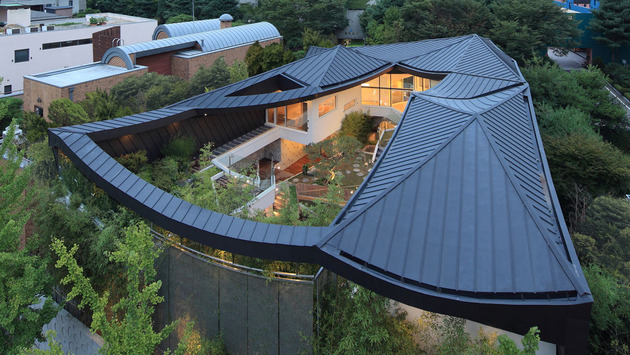Design Korea has posted some pictures of a Korean house with a cutaway roof, designed by the Korean architecture firm IROJE KHM.
The house looks exquisite, if perhaps a bit awkward to furnish. But what I find fascinating about it, beyond the intrinsic cleverness and whimsy, is how well it manages to be at once contemporary and rooted in local tradition — in this case, that of the Korean hanok,
I find this fascinating not just for its intrinsic cleverness, but because it is a very rare example of an architecture that feels at once contemporary and rooted in a local tradition — in this case, the Korean hanok, with its dark-gray sloped roof and its interior courtyard.
It’s a synthesis that’s hard to pull off. Too often, especially in Asia, the attempt to integrate local traditions into modern architecture results in modernism with retro decorative flourishes. But it’s not surprising to me that Korean architects would be feeling their way toward a deeper fusion. Korea has made a concerted effort over the past decade to find ways to bring its traditional culture into its modern culture.
Korea has an interesting history when it comes to working with its own traditions. China went through the Cultural Revolution, during which traditional culture was vilified and destroyed in an orgy of violence. Japan, on the other hand, after the rapid modernization of the Meiji Restoration, suffered the defeat of its modern nation while retaining its emperor, leading to a reactionary cultural conservatism that’s much less prominent in Korea. Korea (and here I mean South Korea) has used its traditional culture for various purposes in the modern era, first as a rallying point for national autonomy against Japanese colonialism, and later both to legitimate the conservative military government and to rebel against it. The result is perhaps more flexibility than one finds in either China or Japan when it comes to working with traditional culture in a modern context.
When I first came to Korea, in 2001, traditional culture was still somewhat fenced off, seen as maybe a bit of an embarrassment by a country keen on taking its place among the developed nations. But as Korea has grown more confident, there has been more willingness not just to preserve traditions, but to extend them, to grow them, to let them live and breathe. This unusual house is just one example of many, and a rare architectural example. I hope to see more such architectural innovation coming out of Korea.

